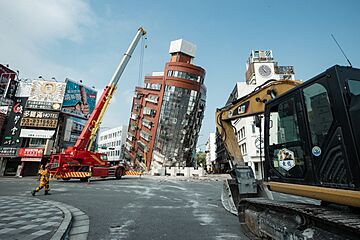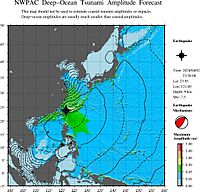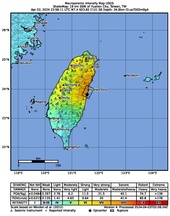2024 Hualien earthquake facts for kids

Rescue workers near the semi-collapsed ten-story Uranus building on Xuanyuan Road
|
|
| UTC time | 2024-04-02 23:58:11 |
|---|---|
| ISC event | 637103828 |
| USGS-ANSS | ComCat |
| Local date | 3 April 2024 |
| Local time | 07:58:11 |
| Magnitude | ML 7.2 Mw 7.4 MJMA 7.7 |
| Depth | 34.8 km (22 mi) |
| Epicenter | 23°49′08″N 121°33′43″E / 23.819°N 121.562°E near Hualien City, Hualien County, Taiwan |
| Type | Reverse |
| Areas affected | Taiwan |
| Max. intensity | CWA 6+ VIII (Severe) |
| Tsunami | 82 cm (2.69 ft) |
| Landslides | Yes |
| Aftershocks | Mw6.4, Mww5.7 |
| Casualties | 10 dead, 1,067 injured, 38 missing, 660 trapped |
On 3 April 2024, at 07:58:11 NST (23:58:11 UTC on 2 April), a Mw 7.4 earthquake struck 18 km (11 mi) south-southwest of Hualien City, Hualien County, Taiwan. At least 10 people died and over 1,000 were injured in the earthquake. It is the largest earthquake in Taiwan since the 1999 Jiji earthquake, with several aftershocks above Mw 5.0 occurring.
Tectonic setting
Taiwan has a history of many strong earthquakes. The island is located within a complex zone of convergence between the Philippine Sea Plate and Eurasian Plate. At the location of the earthquake, these plates converge at a rate of 75 millimetres (3.0 in) per year. To the south of Taiwan, oceanic crust of the Eurasian Plate is subducting beneath the Philippine Sea Plate creating an island arc, the Luzon Arc. At Taiwan, the oceanic crust has all been subducted and the arc is colliding with continental crust of the Eurasian Plate. To the north of Taiwan the Philippine Sea Plate is in contrast subducting beneath the Eurasian Plate, forming the Ryukyu Arc.
Earthquake
Taiwan's Central Weather Administration measured the earthquake's local magnitude at 7.2. At least 300 aftershocks were recorded following the earthquake. A Mw6.4 aftershock struck at 00:11 UTC, followed by a Mw5.7 event at 00:35, a Mw5.5 at 00:43 and a Mw5.7 at 00:46. The mainshock was the strongest earthquake to hit Taiwan since the 1999 Jiji earthquake, which measured Mw7.7.
The earthquake had a maximum CWA seismic intensity of 6+ in Hualien City and 5- in Taipei. Intensity 4 or higher was felt across much of the island except its southern extent, which felt intensities 2 to 3. In China, shaking was felt in Shanghai, Suzhou, Shenzhen, Guangzhou, Shantou, and parts of Fujian, Zhejiang, and Jiangsu provinces. It was also felt in Hong Kong and on the island of Yonaguni, Japan, where it measured Shindo 4 on the Japan Meteorological Agency seismic intensity scale.
The earthquake had a focal mechanism corresponding to reverse-faulting at a 34.8 km (21.6 mi) depth. According to the United States Geological Survey, the rupture occurred on a northeast–southwest-striking, moderately dipping, reverse fault within the Eurasian Plate. The estimated rupture dimensions for a similarly sized reverse-faulting earthquake is 60 km (37 mi) by 35 km (22 mi). Its finite fault model indicated rupture on an east-southeast dipping plane. The slip occurred within an elliptical rupture area 60 km (37 mi) by 60 km (37 mi) on the plane. The maximum displacement was estimated at 1.2471 m (4 ft 1.10 in). The shock's magnitude was identical to a 1986 earthquake that killed 15 people in Hualien.
The China Earthquake Administration (PRC) estimated the earthquake rupture process did not exceed 35 seconds in duration. The slip was distributed across a fault 50 km (31 mi) across. According to their finite fault model, slip was mainly concentrated around the epicenter, reaching 3 m (9.8 ft) of maximum displacement. The model's geometry consists of a northeast striking fault dipping at a shallow angle to the northwest. About 1 m (3 ft 3 in) of slip occurred at the shallow part of the fault that reaches the seafloor off the island's coast.
Tsunami

A 0.5 m (1 ft 8 in) tsunami was observed in Chenggong, Taitung while an 82 cm (32 in) wave was recorded in Wushi Harbor. The Central Weather Administration of Taiwan issued an alert advising residents to evacuate to higher ground.
The Ministry of Natural Resources of the People's Republic of China issued a second-highest level orange tsunami alert, warning of potential localized waves that could cause significant damage in affected coastal areas.
In the Philippines, evacuations were ordered by the National Disaster Risk Reduction and Management Council in the provinces of Batanes, Cagayan, Isabela and Ilocos Norte following a warning by PHIVOLCS. An advisory was issued to 23 provinces for "high tsunami waves" measuring 3 m (9.8 ft), which was later reduced to 30 cm (12 in). At 10:03 (PST), the Pacific Tsunami Warning Center said "the tsunami threat has now largely passed," prompting PHIVOLCS to cancel the tsunami warning.
The Japan Meteorological Agency issued a tsunami warning for Okinawa Prefecture and as waves of 3 m (9.8 ft) were expected, which was later downgraded to a "tsunami advisory". A 30 cm (12 in) wave was observed at Yonaguni about 15 minutes after the earthquake. Waves were also expected along the Miyako and Yaeyama Islands, with 20 cm (7.9 in)-waves reaching the islands of Miyako and Ishigaki. The tsunami warning was the first to be issued in Okinawa Prefecture since the 2011 Tōhoku earthquake and tsunami, while the tsunami was the first to strike the area since 1998. These warnings prompted flight suspensions in Okinawa and Kagoshima Prefectures; evacuations to the third floors were held at Naha Airport and Miyako Airport. China's Tsunami Warning Centre, which is under the Ministry of Natural Resources, issued its highest alert level at level 1, or red.
Casualties
Ten fatalities have been reported, while at least 1,067 people were reported injured and 660 others were declared stranded. Thirty-eight people were listed as missing. The National Fire Agency recorded at least 1,151 earthquake-related incidents. All fatalities occurred in Hualien County. Among the dead were four killed in Taroko National Park, including three hikers who were caught in a rockfall. Another person died when rockfalls occurred at the Daqingshui Tunnel along the Suhua Highway and crushed his truck. One person also died after their car was hit by a falling boulder at the parking lot of the Huide Tunnel along the Suhua Highway, while another fatality was reported inside a mine in Hejen after being hit by falling rocks. A woman in Hualien died after she returned to her building to retrieve her cat, during which she was pinned down by a column following an aftershock.
Damage
Taiwan's earthquake alert system did not send an advance alert of the mainshock, unlike in previous instances.
Six hundred people were stranded in Taroko National Park. Twelve park visitors, including two Canadian nationals, were stranded along a trail, while 40 others were injured. Injuries were also reported across Hualien City, Yilan, Taipei, New Taipei City, Keelung, Taichung and Taoyuan due to falls or toppled objects. Sixty people were trapped inside the 400 m (1,300 ft) Jinwen Tunnel along the Suhua Highway, while 50 employees of the Silk's Place Hotel Taroko who were traveling in four minibusses were also declared trapped after none of them could be contacted by authorities over the phone. The hotel management later said that the employees were safe, citing three staff who had reached the hotel on foot. The road immediately outside the Qingshui Tunnel caved in, trapping several people inside. Seventy people were also trapped in two rock quarries.
The Central Emergency Operation Center reported at least 2,498 cases of damage nationwide following the earthquake, with 1,140 instances in Taipei, 497 in New Taipei and 366 in Hualien County. At least 125 buildings and 35 road infrastructures were damaged by the earthquake. Of the 28 reported building collapses, 17 of them occurred in Hualien, while the other 11 occurred in Yilan, New Taipei and Keelung. Collapses trapped at least 20 people in the immediate aftermath. Twelve buildings deemed unsafe were ordered demolished by authorities. In Hualien City, two houses, the nine-story Uranus building and a restaurant collapsed, trapping many people inside. One person was found dead while 22 others were later rescued from the Uranus building. A high school building in the city also sustained heavy damage. In Taipei, 249 people were injured, six of them seriously, and 10 houses were severely damaged. A warehouse collapsed in New Taipei City, causing three minor injuries. Fifty people were subsequently rescued from the building. Tiles were dislodged and fell off older buildings and some newer structures in the capital. The Legislative Yuan building also sustained damage to its walls and ceilings, while debris fell from the Liberty Square archway of Chiang Kai-shek Memorial Hall. Subsidence in Xindian District caused seven houses to collapse, forcing 12 people to evacuate. A viaduct of the New Taipei Circular Line was reported to be misaligned, and all service on the Taipei Metro was briefly suspended for safety checks. A portion of the ceiling in Taoyuan International Airport collapsed. Another 68 people were injured in Yilan City, where walls collapsed and water pipes ruptured.
Power outages affected 371,869 homes in Taiwan according to the Ministry of Economic Affairs, of which, 14,833 were in Taichung; 5,306 were restored within approximately 25 minutes of the earthquake. Electricity was restored in 70 percent of households within two hours of the earthquake by Taipower, leaving around 91,000 homes without power. By the morning of 4 April, the number was reduced to 337. Water shortages affected 125,675 households, while outages of natural gas affecting 394 households and internet disruptions were also reported. Eighty cell phone base stations were damaged. There were reports of damaged walls, debris and toppled bricks across much of the island. High-speed railway services across Taiwan were partially suspended and major expressways in the eastern part of the island were closed. No anomalies were recorded in any of Taiwan's three nuclear plants.
Twenty-four landslides were recorded following the earthquake. A massive landslide occurred near Xiulin. The Suhua Highway was closed after sections of it were struck by at least nine rockfalls. Rockfalls occurred on another highway which hit at least 12 cars and injured nine people. A landslide along Provincial Highway 9 between Su'ao and Hualien blocked traffic at Chongde railway station, while a rockfall also occurred in the Heren-Chongde section of the Eastern Trunk line in Hualien. A section of the Central Cross-Island Highway between Dayuling and Taroko was also closed. Two German nationals were reported to have been trapped in a tunnel in Hualien. In Taichung, rockfalls blocked a road, damaging three cars and injuring a driver. A large portion of Guishan Island collapsed into the sea. Six F-16 fighter jets of the Republic of China Air Force were slightly damaged at a base in Hualien. The Education Ministry said that 380 schools suffered damage from the earthquake totaling NT$250 million, mostly in Hualien and Pingtung Counties and Hsinchu City.
Railway services were temporarily suspended in parts of eastern China due to the earthquake.
International reactions
The Taiwan Affairs Office of the People's Republic of China said it was highly concerned with the earthquake and was willing to provide disaster relief assistance. In response, Taiwan's Mainland Affairs Council expressed thanks for its concern but said that there would be no request for assistance from Taiwan.
Japan deployed military aircraft to observe possible damage in Okinawa Prefecture following the tsunami alert. The Japanese government later announced that no damage had occurred. Prime Minister Fumio Kishida expressed condolences and sympathy with Taiwan and offered the government's support. The United States said that it was "ready to provide any necessary assistance". At least 47 countries, including those with no diplomatic relations with it, as well as the European Union, expressed sympathies and offered support to Taiwan.
See also
 In Spanish: Terremoto de Taiwán de 2024 para niños
In Spanish: Terremoto de Taiwán de 2024 para niños
- List of earthquakes in 2024
- List of earthquakes in Taiwan



